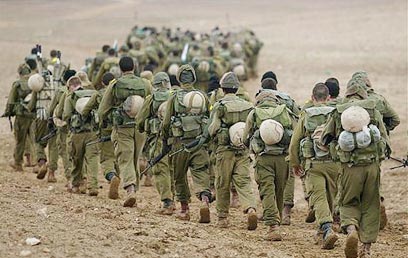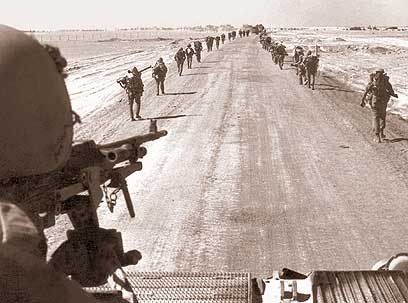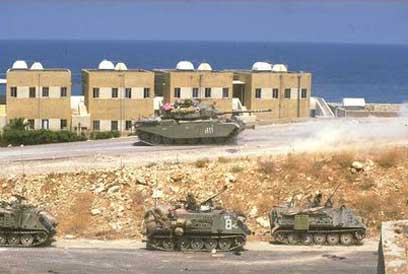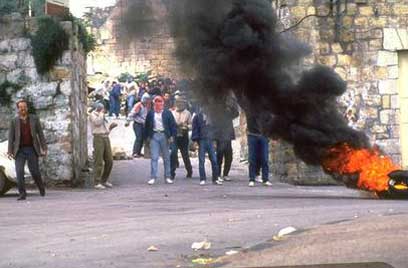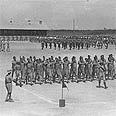
IDF - Israel Defense Forces
The IDF is considered as one of the most skilled armies in combat, and for a long time it had been perceived both in Israel and abroad as one of the best armies in the world. However, the IDF's frequent participation in policing operations, a practice that began during the first intifada, has diminished its army combat abilities in the eyes of many
In the first decades after the establishment of the State of Israel, up until the Six-Day War, the IDF enjoyed the Israeli public's sweeping trust and admiration. The army's prestige peaked immediately after the 1967 war, but in the years that followed, as Israeli society grew increasingly polarized on policy and defense issues, the national consensus over the IDF and its activity weakened.
The Yom Kippur War, the Lebanon War and the escalation of the Israeli-Palestinian conflict marked additional milestones in the deterioration of the public approval of the IDF. The trust placed in its capabilities and morality faded and was replaced with criticism, and its status as an Israeli symbol waned due to ideological and political disputes. The Second Lebanon War dealt another blow to the IDF's standing.
From Establishment of State to Six Day War
The IDF was established on May 26, 1948 on orders of the interim government at the height of the War of Independence. The "IDF Order" declared the formation of an Israeli army that would be comprised of ground, air and naval forces, while outlawing any other armed force other than the IDF.
The IDF top brass was sworn in about a month later. The Haganah's General Command became the first IDF General Command, which established most of the divisions it required in its first days, based on the existing structure of the Haganah. In the following six months, the Lehi and Etzel merged with the IDF while the Palmah was disbanded, in light of the demand that the nation have only one military force.
During the War of Independence, the IDF set up three fronts (which were later called Commands) – North, South and Center. Its units were organized under six battalions, which barely had heavy weaponry. The IDF in its initial days had an air force with several light aircrafts and a tiny naval force.
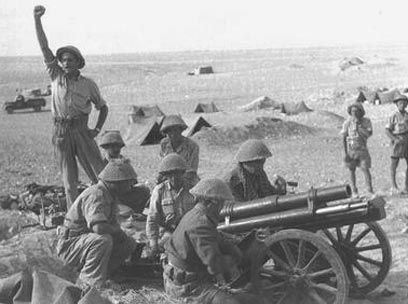
Haganah Chief of Staff Yaakov Dori was named the IDF's first Chief of Staff. Head of the General Command Yigael Yadin was the de facto commander of the war. The civilian in charge of the military was Defense Minister David Ben-Gurion.
The War of Independence ended with armistice treaties rather than peace agreements and the IDF was therefore tasked with upholding a permanent state of alert. It was forced to adapt to facts on the ground: long, penetrable borders and a constant worry of a second round – another attempt by Arab states to conquer Israel.
After the war was over, the Knesset legislated for the first time the military service law of 1949, which was the basis of the army's structural operation and its fighting doctrines. The law stated, among other things, that the army must aspire to move fighting to enemy territory, or alternatively, to launch a preemptive strike due to a lack of geographic strategic depth.
Between 1949 and 1956, the IDF was forced to deal with a surge of border infiltrators, some of whom entered Israel alone to commit robberies and murder, and others who entered later, as part of the Egyptian-backed Fedayeen movement. In 1953, a special forces unit called Unit 101 was established to deal with the infiltrators by striking their camps in the Gaza Strip and Jordan. The unit was later merged with the Paratroopers Brigade.
In those years, the IDF's routine defense activity included frequent retaliation operations against Fedayeen bases, and in some cases against Egyptian and Jordanian military bases as well. The IDF was also tasked with thwarting Egyptian and Syrian attempts to take over Israeli territories, although it was unsuccessful in stopping Syria from capturing the el-Ḥamma enclave (Hamat Gader) and areas in the lower Golan Heights.
During that period, the IDF had to deal with a severe shortage in modern equipment, including tanks, fighter jets, artillery and watercraft. Multiple attempts to reach acquisition agreements with different nations were unsuccessful, and the IDF was forced to make do with purchasing surplus equipment as it became available. The situation took a turn for the better early in 1956, with the enhancement of Israel's defense ties with France. It was then that Israel had a chance to obtain new weapons for the first time.
In 1956, as the attempts to put an end to the border infiltrations proved futile, the IDF launched an offensive on Sinai in cooperation with France and the United Kingdom, who wished to gain control of the Suez Canal. The IDF's Armored Corps reached the canal within a few days, and the Sinai Peninsula was under Israel's control, however briefly. One of the Suez Crisis' first military courses of action, the Battle over the Mitla Pass, is considered one of the most difficult and well-known battles in the history of the IDF.
Following the Suez Crisis, the IDF focused on bolstering the Armored Corps by purchasing modern tanks and upgrading its combat code. The IAF was expanded as well, with the arrival of new jets and helicopters. In the mid-1960s the Armored Corps and the IAF assisted in protecting the Israeli water sources as the conflict with Syria deepened.
In 1964, the United States agreed to sell arms to Israel for the first time. Israel's cooperation with the US on defense matters grew in the years that followed.
History: Six Day War to first Lebanon War
The IDF's demonstrated its capabilities from the very start of the Six Day War. On the morning of June 5, 1967, the IAF launched a strike on the air forces and airports belonging to Egypt, Syria, Jordan and Iraq. Over the course of minutes, the IAF destroyed 350 planes, both on the ground in the air. The IDF fought on three fronts during that war, and made significant military gains as it seized control of the Sinai Peninsula, the Golan Heights, the West Bank and east Jerusalem. Moreover, the Bar Lev Line, a chain of fortifications, was established along the Suez Canal. For the first time, Israel had a strategic advantage.
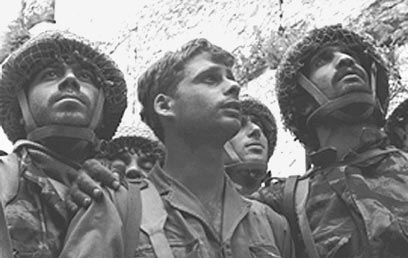
In the years 1969-1970, a War of Attrition took place between Egypt and Israel along the Suez Canal. The bulk of the war consisted of fire exchanges and minor tactics warfare. Meanwhile, with Egypt's encouragement, Palestinian terrorists from Jordan infiltrated the Jordan Valley. Minor exchanges of fire also occurred on the border with Syria.
Following the establishment of the Palestine Liberation Organization (PLO), which had taken upon itself to continue the war on Israel through terror operations, the border infiltrations resurged. The IDF had to allocate increasing resources to fighting against these operations by protecting the border and striking terrorist cells located outside Israel. One of the most renowned operations of that time was a raid carried in Beirut by the elite IDF unit Sayeret Matkal, during which several PLO leaders were killed.
On October 6, 1973, on Yom Kippur, Egypt and Syria launched an all-out war against Israel. Despite the element of surprise, the IDF managed to overcome the disadvantage it suffered during the first days of the war and push the combat into enemy territory. However, the public's trust in the army and the government was shaken.
After the war, the Agranat Commission was established to investigate the military leadership's conduct before and during the war. The commission's findings brought to the dismissal of IDF Chief of Staff David Elazar and other senior officers. The commission criticized the IDF's lack of preparation for the war and for the lack of coordination between the troops. Reforms were consequently implemented in the communication between the different corps and the army's emergency preparedness.
In 1976, a new law determined that the IDF is subordinate to the direction of the government, and that IDF chief of staff – the highest ranking army official – is operative under the Defense Minister's authority.
That same year, the IDF carried out Operation Entebbe, which rescued Israeli hostages from the hands of terrorists who hijacked a passenger plane and flew it to Uganda.
In the mid-1970's, the IDF began aiding the Christian militias in southern Lebanon in the battle against the Palestinian terrorists who took hold of the region. In 1978, the IDF invaded Lebanon, reaching the Litani River. The army retreated from the region after a few months, upon the arrival of UN forces.
Following the signing of the peace treaty with Egypt in 1979, the IDF began retrieving troops and equipment from Sinai. With aid from the US, new military bases and airports were established in the Negev.
In June 1981, the IAF carried out a surprise air strike on Iraq, destroying the nuclear reactor there.
History: Lebanon War and the events that followed
In June of the following year, the IDF launched the Lebanon War. The forces pushed all the way to Beirut while combating militants and the Syrian army. In September, the IDF allowed the Christian Phalangist fighters to enter two refugee camps, Sabra and Shatila, and kill hundreds of Palestinians staying there. The IDF's consent of the massacre caused a stir within the Israeli public, and brought to the establishment of an investigative commission that slammed various Israeli politicians and commanders for their involvement. Defense Minister Ariel Sharon was forced to resign.
In the spring of 1985, the IDF forces returned to Israel. However, some military presence was left to secure a safety zone in southern Lebanon, in cooperation with local forces.
The IDF underwent some organizational changes in the 1980's, including the establishment of the Nahal and Givati infantry brigades. The military also obtained modern war equipment, including F-15 and F-16 planes, Apache helicopters, German submarines, and new Merkava tank models.
In December 1987, the first intifada broke out in the Gaza Strip and the West Bank, forcing the IDF to deal with violent incidents that took place in crowded areas and within hostile populations. New units were established for that purpose, including an undercover unit that sent Israeli spies to assimilate in Arab villages. The army's combat code was enhanced at that time.
In 1991, the first Gulf War broke out, during which Israel faced missile attacks from Iraq. Due to fears that the missiles could include chemical agents, the government urged the citizens of Israel to wear gas masks and hide in protected spaces. After careful consideration, and due to pressure from the US, the Israeli government decided not to retaliate against the attacks.
During the months of June and July 1992, the fighting between Hezbollah and the IDF escalated in the south Lebanon safety zone, prompting the IDF to launch Operation Accountability. After a week-long battle, a ceasefire was mediated with the help of the US. In early 1996, Hezbollah's operations grew frequent yet again, inducing the IDF to breach the Lebanon border. In retaliation, Hezbollah fired Katyusha rockets on communities in northern Israel.
That same year, the IDF launched Operation Grapes of Wrath, which included artillery fire and airstrikes on southern Lebanon. International pressure brought to the conclusion of the operation after an IDF shell hit the village of Kanna, killing a large number of civilians. IDF troops remained in Lebanon until May 2000.
In September 2000, the Al-Aqsa Intifada broke out, virtually killing all hope that the Oslo Accords could bring long-lasting peace. During the uprising, Palestinians carried out thousands of violent acts, including suicide bombings, shootings and mortar fire. The attacks lasted until the IDF took over most of the West Bank yet again in Operation Defensive Shield, and nullified the Palestinian Authority's governing power.
Meanwhile, defense establishment forces made efforts to assassinate and arrest members of terrorist organizations, including Hamas, the Islamic Jihad and the al-Aqsa Martyrs' Brigades. The forces also implemented curfews in the West Bank, built checkpoints and eventually built a security fence. These measures, used to put an end to the violence, drew criticism from within Israel and around the world.
In July 2006, a Hezbollah cell attacked an IDF unit patrolling the Israel-Lebanon border, killing three soldiers and kidnapping two more. Following the incident, the government ordered the IDF to launch a widespread military operation against Hezbollah in Lebanon. During the operation, known as the Second Lebanon War, the IDF carried out hundreds of artillery and air strikes on targets in Lebanon, as well as a few ground assaults close to the border. Hezbollah retaliated by firing hundreds of rockets on northern Israeli communities. In 2006, the war was over after the UN mediated a ceasefire.
The Israeli public was shocked by the events that unfolded during that summer, as they saw their great army incapable of defeating a relatively small guerilla force. In the aftermath of the war, Defense Minister Amir Peretz, IDF Chief of Staff Dan Halutz and several other senior officers resigned.
In December 2008, the IDF launched Operation Cast Lead in the Gaza Strip, aiming to destroy Hamas' infrastructure and halt the rocket attacks on southern Israel. During the operation, the IDF entered the strip, covered by heavy artillery fire and airstrikes. The military activity was completed in January 2009.










